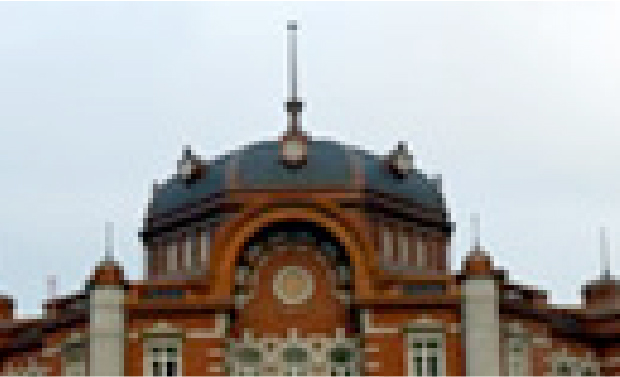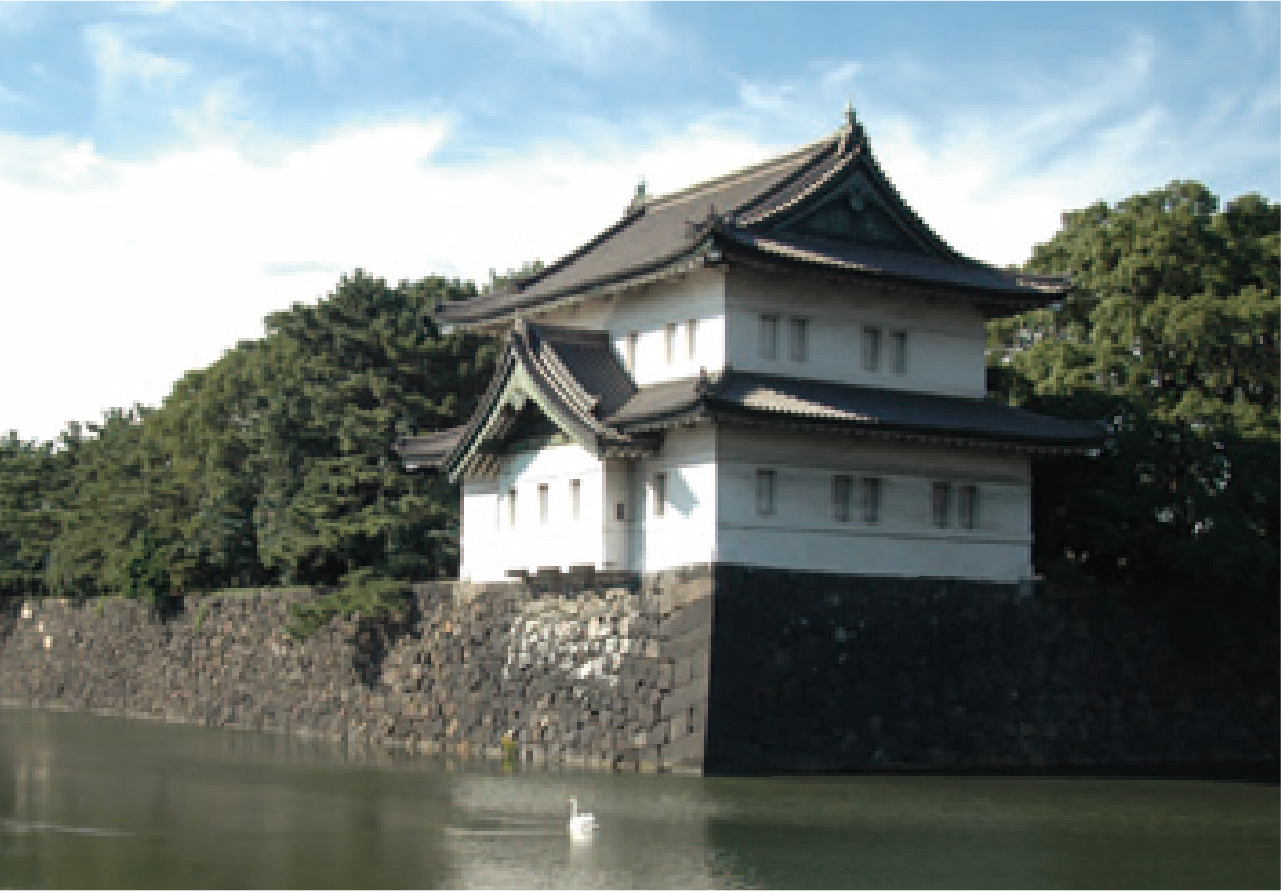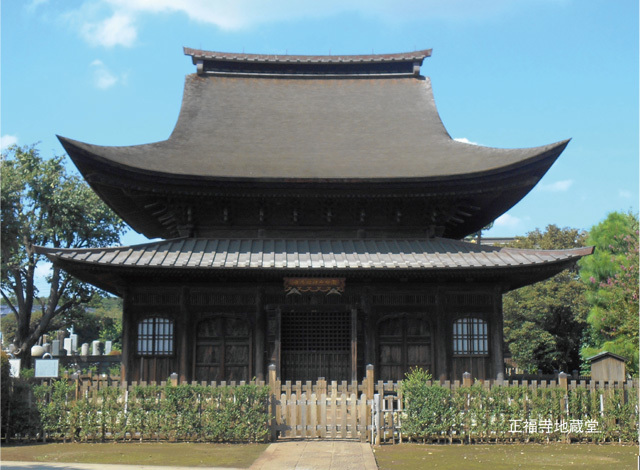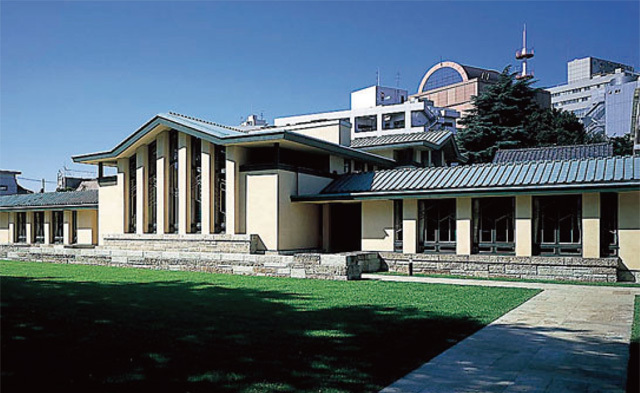
Let's take a stroll through Yaesu
Chuo city Course
Restoration work on the famous red brick facade of Tokyo Station (Marunouchi side) completed in 2012. With this, the "Tokyo Station Marunouchi Main Building" , already designated as a National Important Cultural Property, is now restored to all its original glory for the first time in 67 years.
Take a stroll around the Tokyo Station area, and you'll discover many precious cultural sites dating back to the Edo period. This pamphlet presents a walking course around some of these sites, focusing mainly on the Yaesu North Exit. A great opportunity to sense the history and culture of Edo-Tokyo under fresh autumn skies!
Walking Course Highlights
Route Map


Brochure (PDF)
Chuo city Course
1 Tokyo Station Marunouchi Main Building

Tokyo Station Marunouchi Main Building
Tokyo Station Marunouchi Main Building is a central facility for passenger transport at the heart of Japan's railway network. Built in line with plans drawn up in the Meiji period, this valuable building stands as a symbol of the capital Tokyo. It is one the largest buildings made primarily of brick.
An elevated line running between the stations at Shimbashi (terminus for the Tokaido region) and Ueno (terminus for Tohoku) was planned in 1889, and Tokyo Station was opened in December 1914. At first, only the buildings on the Marunouchi side facing the Imperial Palace were built; the Yaesu exit on the east side was not opened until 1929.
This Marunouchi Main Building was designed by Tatsuno Kingo. It is a massive structure boasting a total length of 335m, including bends in its north-south axis. Elongated wings extend to north and south from a central block, with octagonal domed concourses arranged symmetrically in each of the north and south wings. At first, it was a three-story building with an aggregate floorspace of 10,500 m² - more than twice the size of Tokyo Dome.
The building was damaged in wartime air raids, and underwent emergency postwar reconstruction. The scale of the building was reduced in the process; among other changes, the third floor section was removed and the north and south domes were demolished.
A movement to conserve the redbrick station building started in reaction to redevelopment plans following the privatization and division of Japan National Railways in 1987. This led to its designation as National Important Cultural Property in 2003. The restoration work started in 2007, the aim being to return the buildings (particularly the exteriors) to their state when first built. This included restoring the third floor section and the north and south domes that had been removed in the postwar reconstruction. The natural slates on the roof were sent for repair and storage to the original production site in Ishinomaki, Miyagi Prefecture, where they were damaged by salt due to the 2011 tsunami. As a result, only 45,000 of the 65,000 slates were usable, the rest being purchased from Spain.
Chuo city Course
2 Site of the North Magistrate's Office

Site of the North Magistrate's Office (Photo taken during the excavation)
Local magistrates in Edo had broad-ranging powers, including administration, justice and policing. One magistrate was appointed to the north of the city and one to the south, their offices moving several times.
The office of the North Magistrate was located inside the Gofukubashi Gate from 1806 to the end of the Edo period (1867). This is near what is now the Nihonbashi Exit of Tokyo Station, southwest of the Gofukubashi crossing. A chamfered stone with smoothed edges was discovered when a gully in the northeast of the premises was being excavated. It is said to have had the magical significance of protecting the 'unlucky' ushitora (northeastern) gate of the residence. A reconstructed stone gully and explanation board can be found by the sidewalk on the east side of Marunouchi Trust City.
Toyama Saemon no Jo Kagemoto, the real-life model for the character 'Toyama no Kin-san' portrayed variously by Takahashi Hideki and Matsukata Hiroshi, was the North Magistrate towards the end of the Edo period. His opposition to the Tenpo Reforms led to his dismissal after only three years. While in the post he had defended the townspeople and their amusements, and this was remembered in a popular trend for plays about "Kin-san". He was later recalled as South Magistrate, a post in which he served for seven years. It was very unusual for anyone to hold both of these posts in their lifetime. The site of the South Magistrate's Office is on the southeast side of Yurakucho Station today.
Chuo city Course
3 Ikkoku Bridge Stone Marker for Lost Children

Ikkoku Bridge Stone Marker for Lost Children
The area around Nihonbashi and Ikkoku Bridge was an amusement quarter in the Edo period, and children as well as adults often seem to have gotten lost there. In those days, each neighborhood was responsible for finding lost children, and in 1857, local headmen and others constructed a stone marker for lost children on Ikkoku Bridge.
The words Mayoigo no shirube (Signpost for Lost Children) are engraved on the front, with Tazunuru kata (Persons Missing) on the left side and Shirasuru kata (Persons Giving Notice) on the right. A square recess can be found at the top of each side. In the recess on the left, people would post notices describing the missing child or adult. People with information on missing persons would post notices to that effect in the recess on the right. It was a kind of public notice board for the people of Edo. Similar stone posts existed at other well-frequented places such as Yushima Tenjin Shrine (original still exists) , Sensoji Temple (restored) and Ryogoku Bridge.
To the north of Ikkoku Bridge was the residence of Goto Shozaburo, controller of the Kinza gold mint, while that of Goto Nuinosuke, headman of Gofukumachi, lay to the south. The name Ikkoku is said to have been a play on the word goto, which meant "five to" (a measure of volume), two of which equaled ikkoku or "one koku" (a bout 278 litersor 150kg).
Chuo city Course
4 Ruins of the Tokiwabashi Gate (National Historic Site)

Ruins of the Tokiwabashi Gate (National Historic Site)
The Tokiwabashi Gate, a point of entry in the outer wall of Edo Castle, was built by a Tohoku daimyo in 1629. It was one of the masugata mon (gates backed by a box-shaped enclosure surrounded by stone walls) that were used to defend the castle. The gate had various names in former times, including "Otteguchi" (because it was the main gate over the outer moat) and "Asakusaguchi" (because it led to Asakusa). The present name, Tokiwabashi, is said to have been provided by the 3rd shogun Iemitsu. There are various theories behind this name. One is that it comes from a poem in Volume 1 of the Kinyo Waka Shu (Collection of Golden Leaves, a 12th century anthology): "Iro kahenu matsu ni yosohete Azumaji no Tokiwa no hashi ni kakaru fujinami" (Wisteria flowers swinging over the Tokiwa (immortal) bridge to the road to the east as evergreen pine.). Another suggests that "Tokiwa" (evergreen) celebrates the evergreen pine or matsu element in "Matsudaira" , former surname of the Tokugawa family.
The Tokiwabashi Gate led to the Oshu Kaido, one of the major highways leading out of the capital. As such, it counted as one of the pivotal "five entrances to Edo" connecting Edo Castle with major highways; the others were the Tayasu Gate (leading to the Joshu Kaido), the Kandabashi Gate (the road to Shibazaki), the Hanzo Gate (the Koshu Kaido) and the Outer Sakurada Gate (the road to Odawara and the old Tokaido). These were important gates used by the shogun' s family as well as the Mito Tokugawa family.
The gate itself fell into disuse in 1873, after which the stone walls were partly demolished. However, as this was the best preserved of the castle's outer wall gates, it was designated as a Historic Site in 1928. In 1877, meanwhile, the wooden bridge had been replaced by a western-style stone structure with two arches (earning it the moniker 'Meganebashi' or Glasses Bridge). This is the oldest surviving stone bridge in Tokyo. The name 'Tokiwa' can be written with two variant characters, ![]() and
and ![]() . The former is said to have been chosen because the latter includes the element
. The former is said to have been chosen because the latter includes the element ![]() ('dish'), which is considered unlucky because it is breakable.
('dish'), which is considered unlucky because it is breakable.
∗ After the Great East Japan Earthquake of 2011, the stone walls and bridge were deemed to pose a public safety hazard. They are therefore undergoing restoration work and are closed to the public.
Chuo city Course
5 Bank of Japan Head Office Building

Bank of Japan Head Office Building
The Bank of Japan started business near the approach to Eitai Bridge in 1882, but only one year later decided to relocate owing to lack of space and the distance from the city center. So it was that, in 1896, the Main Building of the Bank of Japan Head Office was completed at its current site, the location of the gold mint in the Edo period.
The building was designed by Tatsuno Kingo, a master of modern architecture who had also created the redbrick building of Tokyo Station. As part of the design process, he spent 14 months visiting banks in western countries. He is said to have modeled his eventual design on the National Bank of Belgium, the most advanced example at the time.
The Main Building has three stories above ground and one below. Although features such as the central dome and entrance pillars are in Neo-baroque style, the building also incorporates Renaissance characteristics in its high symmetry, walls and other design features. It also boasts some advanced facilities that were rare in Japan at the time, including flush toilets, elevators and fireproof shutters. The initial plan was that the building be made completely of stone, but that changed following the Mino-Owari Earthquake in southern Gifu Prefecture in the year after the work started. Now, it is a brick-masonry building with a double wall structure, in which bricks are laid inside and outside the stone walls to make the building more resistant to earthquakes. As a result, when the Great Kanto Earthquake struck in 1923, the actual structure of the building itself remained intact, although the central dome and the majority of the interior were burnt by fires resulting from the earthquake. Moreover, no major damage was suffered when hand grenades were thrown in the attempted coup d' état of May 15, 1932, or in the Tokyo air raids in 1945. As a result, the building remains more or less in its original condition today.
From above, the Bank of Japan Head Office Building is shaped like the Japanese character for "yen". This is probably just a coincidence, however, as an older form of the character was in use when the bank was originally built.
Chuo city Course
6 Mitsui Main Building

Mitsui Main Building
The Mitsui Main Building is located on a site where Mitsui Takatoshi, who laid the foundations of the Mitsui zaibatsu in the Edo period, had a clothing store called 'Echigoya'. The old building was rebuilt following damage caused by the Great Kanto Earthquake, and the reconstruction was completed in 1929.
The design was overseen by Trowbridge & Livingston of New York and the construction by James Stewart & Co., using the very latest American design and technology of the day. For its architectural style, the building adopted a Neo-classical Greek revivalist theme, as commonly seen in public edifices of 19th century America. It is surrounded on three sides by rows of magnificent Corinthian columns. Taking a lesson from the Great Kanto Earthquake, the structure of the building was designed to withstand earthquakes of twice its magnitude. The door of the main vault is 2.5m in diameter with a maximum thickness of 0.55m, and weighs 50 tons. According to a surviving anecdote, when it was being transported to the site, its sheer weight meant that it was not permitted to be carried over Nihonbashi Bridge. Instead, it had to be taken by ship to the foot of the Shin-Tokiwa Bridge and then hauled up onto land from there. The Main Building was once occupied by the Head Offices of Mitsui Gomei Kaisha, Mitsui Bank (now the Sumitomo Mitsui Bank), Mitsui Trust & Banking (now the Chuo Mitsui Trust and Banking Co.), Mitsui & Co., and Mitsui Mining (now Nippon Coke & Engineering Co., Ltd.), among others. As such, it functioned as a veritable center of operations for the Mitsui zaibatsu. After the war, part of the building was requisitioned by GHQ (the General Headquarters of the Supreme Commander for the Allies Powers).
Today, the Main Building is home to the Mitsui Memorial Museum, housing approximately 4,000 precious works of art collected by the Mitsui family since the Edo period.
* As the 5th and 6th floors are occupied by offices, access is limited in some areas. The sales floors of Sumitomo Mitsui Bank may only be viewed during office hours. There are no plans for publicizing cultural properties inside the building in guidebooks or similar.
Chuo city Course
7 Mitsukoshi Main Store

Mitsukoshi Main Store
Like the Mitsui Main Building, Mitsukoshi has its origins in the Echigoya store; it inherited the latter's clothing business, only later evolving into a department store. The name 'Mitsukoshi' (![]() ) is taken from the first characters of the Mitsui zaibatsu (
) is taken from the first characters of the Mitsui zaibatsu (![]() ) and Echigoya (
) and Echigoya (![]() ).
).
While Mitsukoshi was still a clothing business, the Main Store was completed in 1914 as a steel-reinforced concrete building in Renaissance style. At the time, it was lauded as "the largest building east of the Suez Canal" . Though partly burnt by fires following the Great Kanto Earthquake, it was later refurbished and extended, reaching its current form in 1935.
A pair of bronze lions guard either side of the main entrance. Modeled on the lions in London's Trafalgar Square, they were cast in Britain over a period of three years. These lions have now become a kind of "wish-fulfillment symbol" ; legend has it that if anyone succeeds in riding one without being seen, their wishes will come true. This makes the lions particularly popular with students preparing for exams. The "wish-fulfillment" legend is central to the narrative of Shishi to Chikatetsu (The Lions and the Underground), a short story in Sagi to Yuki (Herons and Snow) by Kitamura Kaoru, which won the Naoki Prize.
Signs of art deco style can be found here and there inside the building, while a gorgeously ornate statue of an angel representing 'sincerity' towers over the multi-level Central Hall. The statue is now a symbol of the Mitsukoshi Main Store. The pipe organ on the 2nd floor balcony over the Central Hall has been designated as a Tangible Cultural Property of Chuo City, as the only surviving theater organ from the early Showa era that is still playable. The marble used for the interiors contains a number of fossils. In particular, the figure of an ammonite can be clearly seen in the wall on the stairway leading from the Central Hall to the 2nd floor. The building boasted the first escalator in Japan, as well as some of the latest facilities of the day, including elevators, sprinklers, and full heating and ventilation throughout.
Chuo city Course
8 Miura Anjin Monument

Miura Anjin Monument
William Adams, known in Japanese as Miura Anjin, was an English sailor who set sail for the Far East on the Dutch ship De Liefde, which drifted ashore at Usuki in Bungo (now Oita Prefecture) in 1600. Summoned by Tokugawa Ieyasu, Adams gave guidance in many subjects including the contemporary international scene, shipbuilding and navigation, astronomy and mathematics. In reward for his achievements he was given the title of hatamoto (shogun's flag-bearing retainer) and granted a fief in Miura County, Sagami (now Kanagawa Prefecture), as well as a residence in Edo. His Japanese surname Miura reflects the name of his fief, while 'Anjin' meant a pilot of a ship. The site of his residence is in the area of today's Nihonbashi Muromachi 1-Chome, which was known as "Anjin-cho" until the early Showa era. A street called "Anjin-dori" still survives today, and a stone monument marks the "Historical Site of the Residence of Miura Anjin".
Jan Joosten, one of Will Adams' companions on De Liefde, was also invited to Edo, and the area around his residence came to be called "Yayosu Quay" after the local pronunciation of his name. This survives today as "Yaesu". Meanwhile, the cannons carried by De Liefde were reportedly used in the Battle of Sekigahara and the Siege of Osaka.
Chuo city Course
9 Nihonbashi Bridge

Nihonbashi Bridge
The first wooden bridge was built here in 1603, and in the following year, Nihonbashi became the starting point of the five major highways. To the east, the bustling Uogashi fish market lined the banks of the Nihonbashi River as far as the next bridge, Edobashi. Areas to the north and south of the bridge were occupied by merchants' stores including Shirokiya and Echigoya, making this the busiest place in all of Edo. Fires were common in Edo, breaking out ten times here in recorded accounts alone. In all, the bridge had a length of 28 spans measuring about 51m in total, and a width of 4 spans measuring about 8m. The Edo-Tokyo Museum has a full-scale replica of the northern 14 spans, based on records from the Late Edo period. This half of the reconstructed bridge can actually be crossed there.
The Nihonbashi Bridge was rebuilt in stone in the Meiji era. The present version, 49m long and 28m wide with two stone arches, was completed in 1911. A 'point zero' marker, indicating the starting point for distances on Japan's road network, is embedded in the middle of the bridge, with a replica displayed at the northwest end. Seven national highways start from Nihonbashi - Routes 1 (the Tokaido), 4 (Nikko Kaido), 6 (Mito Kaido), 14 (Chiba Kaido), 15 (Dai-Ichi Keihin), 17 (Nakasendo) and 20 (Koshu Kaido).
Plaques commemorating the construction work can be found at the northeastern and southeastern bridge ends. The plaques are positioned on the river-facing sides of the bridge piers, and can only be seen by leaning over the bridge. Please take great care when doing so.
Chuo city Course
10 Shirokiya Spring Well

Shirokiya Spring Well
To the south of Nihonbashi Bridge stood the Shirokiya store. Founded by the Omi merchant Omura Hikotaro, this was a major clothing retailer to rival Echigoya on the north side. In 1711, Hikotaro's son (also called Hikotaro) dug a well inside the store to solve water problems in the Nihonbashi area. While this difficult work was underway, legend has it that a statue of Kannon (the Buddhist Goddess of Mercy) was discovered, whereupon streams of spring water started to gush out. And from that time on, the well was known as the "Shiroki Spring", not only amongst local residents but also more widely. The Matsudaira of Echizen are said to have drawn water from the well every morning until the Meiji Restoration, because the Clan Head had been cured by it.
In 1932, Japan's first fire in a multistory building broke out at Shirokiya. Ropes were let out of the upper floor windows to help people escape, but women in kimonos fell to their deaths when they let go of the ropes to hold their hems down. This is said to have started a trend towards western-style women's underwear, but the story is probably a later embellishment.
When Shirokiya's successor, the Nihonbashi Branch of Tokyu Department Store, closed its doors in 1999, the Shiroki Spring disappeared. The Kannon statue was enshrined at Sensoji Temple in Asakusa, and the stone monument to the "Shirokiya Spring Well" was moved to its current location next to the plaza in front of COREDO Nihonbashi Annex.
Chuo city Course
11 Takashimaya Tokyo Store

Takashimaya Tokyo Store
"Takashimaya", a secondhand clothing and cotton cloth retailer founded in Kyoto in 1831, opened its Tokyo Store at Nihonbashi in 1933. It was located in the "Nihon Seimei Building" erected by Nippon Life Insurance Co., which rented the building to Takashimaya.
A proposal by Takahashi Teitaro, who had already designed the Gakushi Kaikan Building and the Residence of Marquis Maeda in Komaba, was adopted for the building's architectural design. Takahashi incorporated copious elements of Japanese architecture within western historical styles, under his concept of "contemporary architecture based on a keynote of oriental tastes". Later, extensions designed by Murano Togo using the techniques of modern architecture were added over a period of around 30 years, while preserving Takahashi's original ideas. This led to the building's appearance today as a splendid fusion of Takahashi's and Murano's designs.
Takashimaya was the first department store in Japan to be fully fitted with air-conditioning equipment; the advertising copy used in those early days - "It's hot in Tokyo when you step out of Takashima" - took Japanese society by storm. The elevators, operated manually by store guides, are still used today, albeit with much modernized machinery and repaired cages. These are now one of the faces by which the Takashimaya Tokyo Store is best known.
For four years from 1950, Takako the Elephant was reared on the roof of the store, giving it notoriety as "the department store with the elephant". Takako was apparently lifted up by a crane. She was later donated to Ueno Zoo, but a penthouse on the motif of a baby elephant still remains on the rooftop today.
Tokyo Cultural Heritage Map
Would you like to go around cultural heritages? In Tokyo, there are various cultural heritages. This map helps you go around cultural heritages with efficiency during limited time in your trip. Japanese traditional temples and shrines, the cultural heritages concerned to most famous events and person in Japan and a lot of nature. This map introduces all of them widely! You must watch them and know the history and the culture of Tokyo!

SNS




















